Peak oil, the energy crisis is here and it will last
| 01 June 2008 - Comments (1) | Reflections |
 If the price of oil is any indicator, it is clear that we are at the begining of an energy crisis. But this one, unlike any other we had in the past, is profound, structural and will last for as long as our dependance on fossil energy lasts. We have reached or are just about to reach the maximum oil production. From there on, it is a downward slope coupled with an increasing demand. Let's explore what this means for all of us.
If the price of oil is any indicator, it is clear that we are at the begining of an energy crisis. But this one, unlike any other we had in the past, is profound, structural and will last for as long as our dependance on fossil energy lasts. We have reached or are just about to reach the maximum oil production. From there on, it is a downward slope coupled with an increasing demand. Let's explore what this means for all of us.
Growing demand for primary energy
All of our modern development has been fueled by cheap fossil energy from oil, gas and coal (and to a lesser extend from uranium through nuclear power). The particularity of those fossil fuels is to be non-renewable. There is a limited amount of it in the ground and as we take it out, that amount is diminishing. Over the past decades, the use of the exploited reserves has been offset by the discovery of new ones and the production was able to ramp up tremendously. But overall, global reserves have been diminishing.
For long, it had been thought that reserves were so great, there was little reason to start thinking about alternatives. There was strong faith in the progress of technology and future discoveries to suppose that solutions would be found in time when the problem of fossil fuel supply would occur. So we continued to use more and more fossil energy to power our ever growing economy. In fact, growth has become the only path forward for the world economy, and that growth is tightly dependent on the availability of affordable abundant energy.
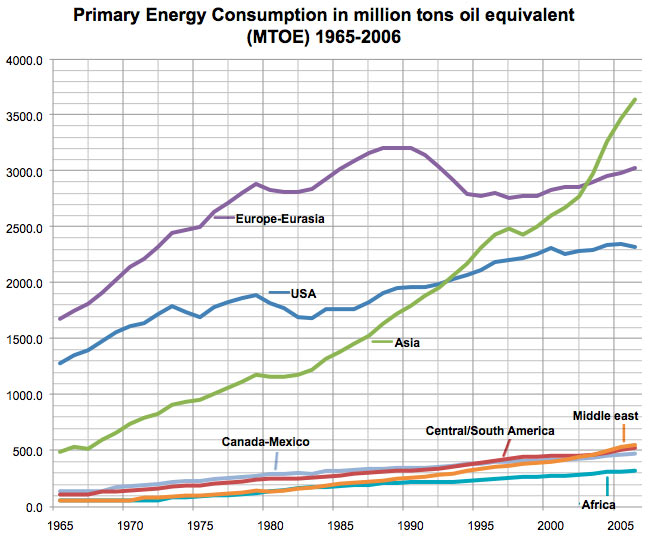
Primary Energy Consumption in million tons oil equivalent (MTOE) 1965-2006
Primary energy comprises commercially traded fuels only. Excluded are fuels such as wood, peat and animal waste (important in many countries but unreliably documented). Also excluded are wind, geothermal and solar power generation.
Data from BP Statistical Review of World Energy June 2007, graph by Lionel Mestre.
Industrialized countries, such as European ones, have started to stabilize their demand on fossil energy because of their slow growth, by rationalizing their use of energy and by increasing their use of renewable energy. But developing countries, particularly China and India, are growing at such great speed that their demand on fossil energy is exploding. Yet, it's hard to blame them as they are still using only a fraction of what the industrialized countries are using per person.
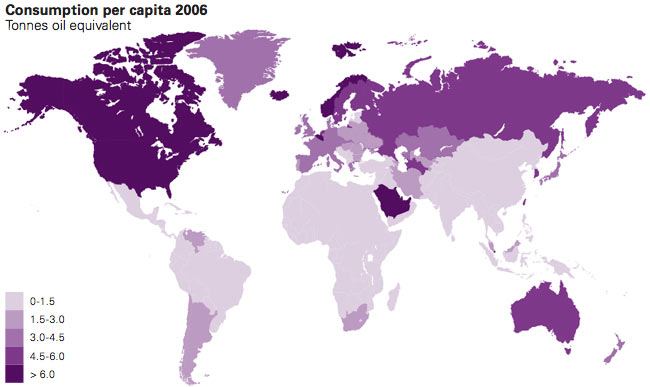
Consumption of primary energy per capita 2006 in tonnes of oil equivalent per person
Source BP Global.
The demand on energy is also linked to the growth of the population. If industrialized countries have mostly stabilized their demography, population in Asia is still on the rise. In Asia, the combination of population growth, massive industrialization, rise of weathly classes is pushing the very strong and increasing demand on energy.
The importance of oil in the primary energy we use
Oil is playing a very important role as a source of primary energy. In all regions of the world, oil is the most important or the second most important source of energy. Globally, oil is first and constitutes 36% of all the primary energy used in the world (see graph below).
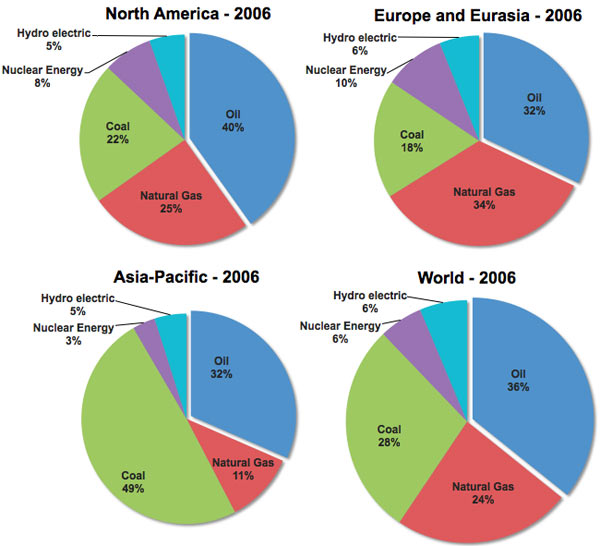
Repartition of the Primary Energy Consumption by fuel in 2006 for North America, Europe-Eurasia, Asia-Pacific and for the world combined
Primary energy comprises commercially traded fuels only. Excluded are fuels such as wood, peat and animal waste (important in many countries) but unreliably documented. Also excluded are wind, geothermal and solar power generation.
Data from BP Statistical Review of World Energy June 2007, graph by Lionel Mestre.
In industrialized countries, most of the oil is used for fueling transportation. In the USA, which consumes around 1/4 of the worldwide production of oil, the transportation sector is using more than 2/3 of that oil. When you do the maths, you can see the unfairness of the situation. American people are using 10% of the oil worldwide only to power their cars. To compare, Africa is using only 3,4% of the oil worldwide to live.
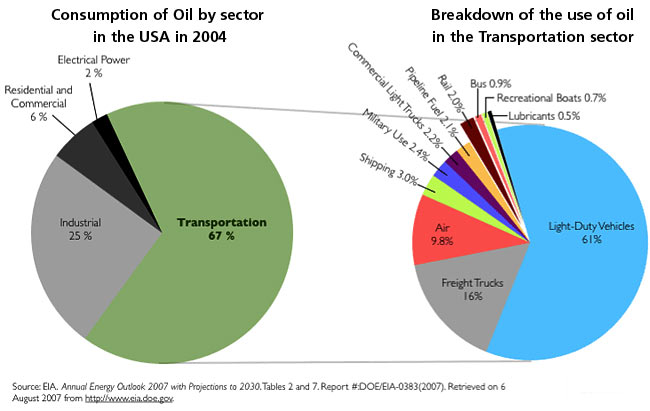
Oil Consumption by sector in the USA (2004)
More than 2/3 of the oil is used for transportation. Most of the oil used for transportation is used for light-duty vehicles. Source Rocky Mountain Institute.
This especially unfair because in developing countries, the use of oil is completely different. Lots of them are using it to generate electricity. In Senegal for instance, around 70% of electricity is generated from oil.
In Asia, still lagging far behind North America and Europe in term of individual transportation, their use of oil is much less than coal, which provides half of their energy (mainly for the industry and the production of electricity). But the demand for cars is exploding in China and that creates more demand for oil. Over the past 30 years, only Europe and Eurasia reduced the amount of oil they use by switching to natural gas whenever possible after the oil crisis of the seventies. All the other areas increased their demand on oil, Asia seeing the biggest increase.
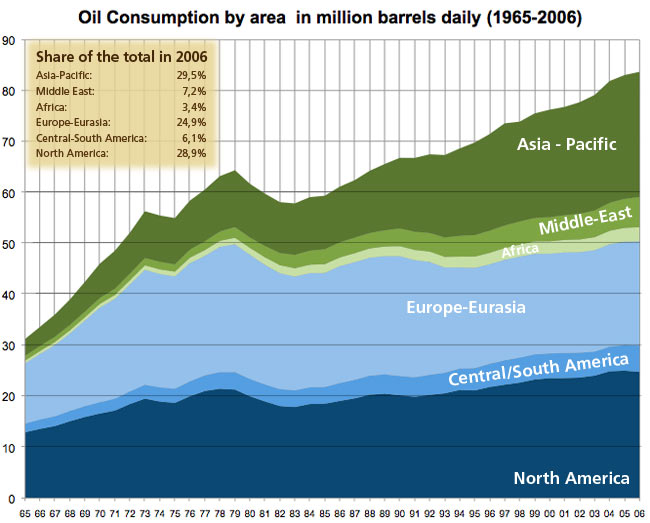
Oil Consumption by area in million barrels daily (1965-2006)
Data from BP Statistical Review of World Energy June 2007, graph by Lionel Mestre.
So worldwide energy demand is on the rise, mainly pushed by China and India. Demand on all three main sources of energy, oil, natural gas and coal is on the rise. The question is therefore: can we extract enough of those fossil fuels to cover that demand? Looking at the case for oil, the answer is clearly: not anymore.
Oil production peak
Extraction of oil is not quite like pumping out water from a tank at a constant flow until there is no more. When an oil field starts production, oil, often under pressure, comes up easily. That is the initial period where extraction quantities increases as wells are sunk one after another. As time goes, water, steam or gas has to be injected to repressurize the wells. Finally, once most of the recoverable oil has been taken out, it becomes impossible to maintain the same production rate. The remaining oil has to be pumped out at a slow rate. Depending on the type of reservoir, recovery of oil varies from 10% to a little more than 50%. Lifetime of an oil field can go from 5 to 10 years to more than 50 years for the biggest fields in the Middle-East.

Typical production pattern for an oil region
Source Energy Watch Group, Oil Report 2007.
In a country producing oil, development of fields will be staged over a period of time. Easiest and biggest fields will be developed first. Then the harder and smaller ones. As more and more fields reach their production peak, the production of the country, which result in the aggregated production of the individual fields, will also eventually peak and decline (see above).

Oil producing countries past peak oil
The year after the country name indicates the year at which this country reached its own oil production peak. Source Energy Watch Group, Oil Report 2007.
This is a very well understood process as it has been experienced already by many countries which passed their own national oil peak.
Global peak oil
As more and more countries are reaching their own national peak, the obvious question is when the world oil production is going to peak, what is called peak oil. Forecasting peak oil has been first studied by M. King Hubbert. In 1956, he successfully predicted the 1971 american oil production peak. He based his model on oil discoveries, predicting rightly that oil production follows oil discoveries in the same bell shape curve.
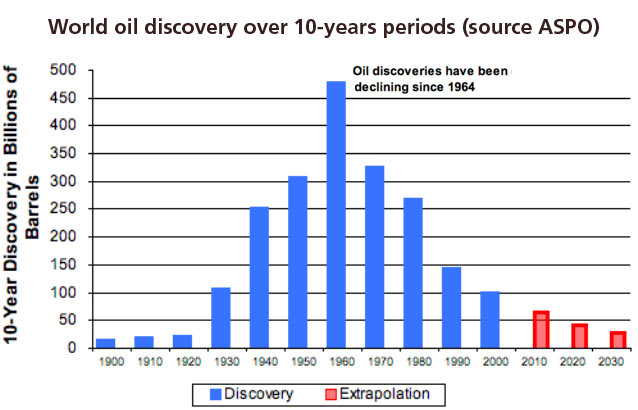
World oil discovery over 10-years periods (source ASPO)
Source The Oil Drum: Peak Oil Overview - March 2008.
Oil discoveries have peaked in the sixties which means that the bulk of oil extracted today is coming from aging fields discovered decades ago. Several independent organizations are studying this very sensitive and political matter. 95% of prediction see a production peak between 2008 and 2010. As of today, the all liquids production peak already happened in July 2006.
Below is the forecast of the world oil production by the Energy Watch Group. For them, peak oil already occurred in 2006. What's more is that, after a few years plateau, they forecast a steep decline in production.
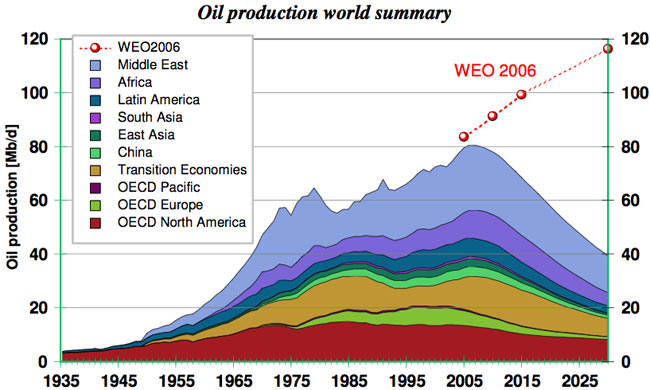
Oil production - world summary and forecast
According to the Energy Watch Group study, peak oil occurred in 2006 and a steady decline in production is to follow. The red dotted line denotes the projection from the World Energy Outlook (WEO) published by the International Energy Agency (IEA) which is completely off the reality.
Source Energy Watch Group, Oil Report 2007.
What does it means for you and me?
Discussing about the real date of the peak is, in fact, irrelevant. What is important to understand is that we are witnessing the end of the era of cheap and abundant energy. Energy is bound to become more and more expensive because of the declining oil production.
We are already seeing the effect of this crisis in the price of oil. Crude oil has never been so expensive, ever. And the global trend is up.

Crude oil prices from 1861-2008 (US dollars per barrel)
Source BP Global (completed up to 2008 by Lionel Mestre).
At the individual level, we should get prepared by freeing ourselves as much as possible from fossil energy. For instance, in the residential sector we are concerned about in Belgrade, it is just plain irresponsible to continue building energy inefficient dwellings using electricity or natural gas for heating. And if it is irresponsible to build such dwellings, it certainly doesn't make any sense for individuals to buy them. Even less at the price they are sold.
May be something will save us?
Can we replace oil with other fuels?
Using more natural gas is possible but it can only cover a small portion of what we use the oil for. And natural gas is a fossil fuel that is following oil in its decline. In addition, more pressure on gas supply will raise its price. Natural gas will probably follow oil in the price rise.
Using more coal is very problematic because of its great contribution to global warming. All industrialized countries are bound to reduce their CO2 emissions and coal is just not an option. Biofuels are not the answer neither as it is very well exposed by David Fridley in “The Myths of Biofuels” (downloadable freely). Nuclear is intrinsically unsafe and uranium is also a depleting resource. Hydrogen or fusion energy are decades away.
At the end, we will likely end up using more natural gas, more coal, more nuclear power, more biofuels but it wont be enough. The very simple truth is that we have a very big problem and no solution for it. We can only try to mitigate the effect of peak oil.
The 2 most effective measures we could take are energy conservation and massive shift toward the use of renewable energy. Energy conservation is the cheapest measure to apply. For instance by increasing the efficiency of transportation, by rethinking urban development to reduce the use of cars or by increasing the energy efficiency in the residential sector. Just driving less could save huge amount of oil.
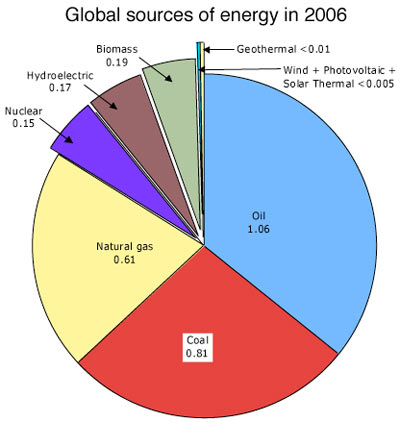
Global source of energy in 2006 expressed in Cubic Mile of Oil (CMO)
Source SRI International.
The use of renewable energy is the way to go. But replacing oil with renewables will take decades. The above graph gives a measure of how much energy we get from fossil fuels and just how little we get from renewable ones.
Conclusion
The scale of the problem is such that we would need dramatic actions from smart politicians to completely change our energy spending and supply policy. There are ways to mitigate and prepare this coming oil supply crunch. The big problem is that everything is linked up together. Oil is used for the production and the transportation of food, natural gas for the production of fertilizers, biofuel makes fuel production compete with food, transportation is essential for most of our economy to function. Scarcity and rising price of energy will have profound effects.
What we didn't mentioned so far is that peak oil is only one symptom of a graver disease: unsustainable development that led to global warming, mass extinction, population overshoot, water crisis, desertification, deforestation and pollution.
So as we are looking to address peak oil, it seems that the right answer is probably to pave the way for responsible and sustainable development. Business as usual is not an option anymore. At Kuće Beodom level, we will do what we can, which is to continue working on energy efficiency and to move strongly toward the use of renewable energy.
To go further
There is a lot of information on the web, many books and documentaries talking about the upcoming oil crisis. On the web:
- The Oil Drum
- The Association for the Study of Peak Oil and Gas (ASPO)
- Energy Bulletin
- The Oil Depletion Analysis Centre (ODAC)
- Global Public Media, Public Service Broadcasting For A Post Carbon World
There is a very good interview of David Fridley on Global Public Media: “Scientist David Fridley on energy, China and globalization”.
Below are some good documentaries. They might be hard to find in Serbia, but they can all be obtained using an Internet connection.













































21/01/2010
Dr James Leigh
1
Article